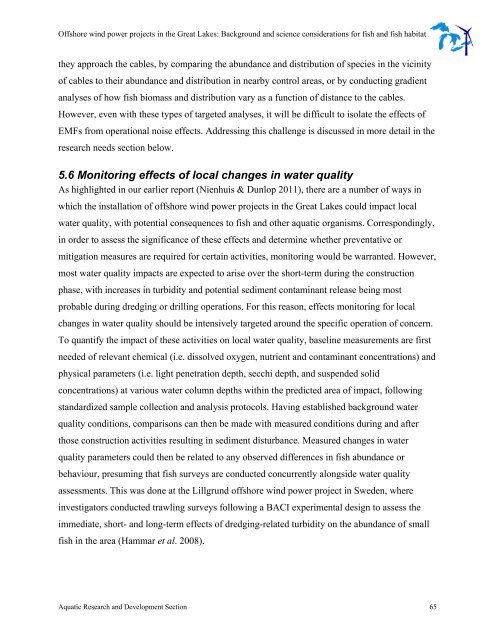Offshore Wind Power Projects in the Great Lakes - Ministry of ...
Offshore Wind Power Projects in the Great Lakes - Ministry of ...
Offshore Wind Power Projects in the Great Lakes - Ministry of ...
Create successful ePaper yourself
Turn your PDF publications into a flip-book with our unique Google optimized e-Paper software.
<strong>Offshore</strong> w<strong>in</strong>d power projects <strong>in</strong> <strong>the</strong> <strong>Great</strong> <strong>Lakes</strong>: Background and science considerations for fish and fish habitat<br />
<strong>the</strong>y approach <strong>the</strong> cables, by compar<strong>in</strong>g <strong>the</strong> abundance and distribution <strong>of</strong> species <strong>in</strong> <strong>the</strong> vic<strong>in</strong>ity<br />
<strong>of</strong> cables to <strong>the</strong>ir abundance and distribution <strong>in</strong> nearby control areas, or by conduct<strong>in</strong>g gradient<br />
analyses <strong>of</strong> how fish biomass and distribution vary as a function <strong>of</strong> distance to <strong>the</strong> cables.<br />
However, even with <strong>the</strong>se types <strong>of</strong> targeted analyses, it will be difficult to isolate <strong>the</strong> effects <strong>of</strong><br />
EMFs from operational noise effects. Address<strong>in</strong>g this challenge is discussed <strong>in</strong> more detail <strong>in</strong> <strong>the</strong><br />
research needs section below.<br />
5.6 Monitor<strong>in</strong>g effects <strong>of</strong> local changes <strong>in</strong> water quality<br />
As highlighted <strong>in</strong> our earlier report (Nienhuis & Dunlop 2011), <strong>the</strong>re are a number <strong>of</strong> ways <strong>in</strong><br />
which <strong>the</strong> <strong>in</strong>stallation <strong>of</strong> <strong>of</strong>fshore w<strong>in</strong>d power projects <strong>in</strong> <strong>the</strong> <strong>Great</strong> <strong>Lakes</strong> could impact local<br />
water quality, with potential consequences to fish and o<strong>the</strong>r aquatic organisms. Correspond<strong>in</strong>gly,<br />
<strong>in</strong> order to assess <strong>the</strong> significance <strong>of</strong> <strong>the</strong>se effects and determ<strong>in</strong>e whe<strong>the</strong>r preventative or<br />
mitigation measures are required for certa<strong>in</strong> activities, monitor<strong>in</strong>g would be warranted. However,<br />
most water quality impacts are expected to arise over <strong>the</strong> short-term dur<strong>in</strong>g <strong>the</strong> construction<br />
phase, with <strong>in</strong>creases <strong>in</strong> turbidity and potential sediment contam<strong>in</strong>ant release be<strong>in</strong>g most<br />
probable dur<strong>in</strong>g dredg<strong>in</strong>g or drill<strong>in</strong>g operations. For this reason, effects monitor<strong>in</strong>g for local<br />
changes <strong>in</strong> water quality should be <strong>in</strong>tensively targeted around <strong>the</strong> specific operation <strong>of</strong> concern.<br />
To quantify <strong>the</strong> impact <strong>of</strong> <strong>the</strong>se activities on local water quality, basel<strong>in</strong>e measurements are first<br />
needed <strong>of</strong> relevant chemical (i.e. dissolved oxygen, nutrient and contam<strong>in</strong>ant concentrations) and<br />
physical parameters (i.e. light penetration depth, secchi depth, and suspended solid<br />
concentrations) at various water column depths with<strong>in</strong> <strong>the</strong> predicted area <strong>of</strong> impact, follow<strong>in</strong>g<br />
standardized sample collection and analysis protocols. Hav<strong>in</strong>g established background water<br />
quality conditions, comparisons can <strong>the</strong>n be made with measured conditions dur<strong>in</strong>g and after<br />
those construction activities result<strong>in</strong>g <strong>in</strong> sediment disturbance. Measured changes <strong>in</strong> water<br />
quality parameters could <strong>the</strong>n be related to any observed differences <strong>in</strong> fish abundance or<br />
behaviour, presum<strong>in</strong>g that fish surveys are conducted concurrently alongside water quality<br />
assessments. This was done at <strong>the</strong> Lillgrund <strong>of</strong>fshore w<strong>in</strong>d power project <strong>in</strong> Sweden, where<br />
<strong>in</strong>vestigators conducted trawl<strong>in</strong>g surveys follow<strong>in</strong>g a BACI experimental design to assess <strong>the</strong><br />
immediate, short- and long-term effects <strong>of</strong> dredg<strong>in</strong>g-related turbidity on <strong>the</strong> abundance <strong>of</strong> small<br />
fish <strong>in</strong> <strong>the</strong> area (Hammar et al. 2008).<br />
Aquatic Research and Development Section 65
















